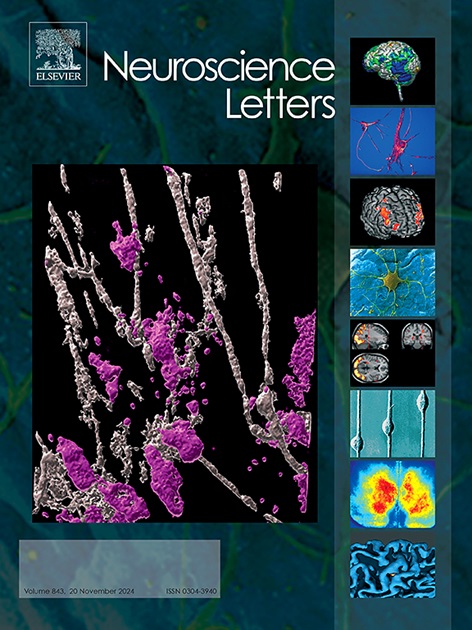mGluR5 regulates inflammatory pain and pain aversion of CFA mice by mediating ERK/PI3K signaling pathway
IF 2
4区 医学
Q3 NEUROSCIENCES
引用次数: 0
Abstract
To investigate whether metabotropic glutamate receptor 5 (mGluR5) in the basolateral amygdala (BLA) regulates inflammatory pain and pain aversion by mediating ERK/PI3K signaling pathway in mice. Two experimental routes were designed. In route 1, 18 male C57BL/6 mice were divided into control, IFA, and CFA groups. In route 2, 18 mice received stereotaxic BLA injections of ACSF, the mGluR5 agonist DHPG, or antagonist MTEP on day 8 following CFA administration. Pain behaviors and aversive emotions were assessed over 14 days. BLA tissues were collected on day 15 for immunofluorescence staining and Western blot analyses of mGluR5, PI3K, p-PI3K, and ERK1/2 expression. The expression levels of p-PI3K, mGluR5 and ERK1/2 in the BLA of CFA mice were significantly increased, suggesting that their activation was associated with inflammatory pain. DHPG increased the expression of p-PI3K and mGluR5 and ERK1/2 in the CFA mouse brain BLA, while MTEP had the opposite effect. Our results show that mGluR5 regulates inflammatory pain and pain aversion of CFA mice by mediating the ERK/PI3K signaling pathway.
mGluR5通过介导ERK/PI3K信号通路调节CFA小鼠炎症性疼痛和疼痛厌恶。
探讨杏仁核基底外侧(BLA)代谢性谷氨酸受体5 (mGluR5)是否通过介导ERK/PI3K信号通路调节小鼠炎症性疼痛和疼痛厌恶。设计了两条实验路线。途径1将18只雄性C57BL/6小鼠分为对照组、IFA组和CFA组。在途径2中,18只小鼠在给药后第8天接受立体定向BLA注射ACSF、mGluR5激动剂DHPG或拮抗剂MTEP。在14 天内评估疼痛行为和厌恶情绪。第15天收集BLA组织进行免疫荧光染色和Western blot分析mGluR5、PI3K、p-PI3K和ERK1/2的表达。p-PI3K、mGluR5和ERK1/2在CFA小鼠BLA中的表达水平显著升高,提示其激活与炎症性疼痛有关。DHPG增加了CFA小鼠脑BLA中p-PI3K、mGluR5和ERK1/2的表达,而MTEP的作用相反。我们的研究结果表明,mGluR5通过介导ERK/PI3K信号通路调节CFA小鼠的炎症性疼痛和疼痛厌恶。
本文章由计算机程序翻译,如有差异,请以英文原文为准。
求助全文
约1分钟内获得全文
求助全文
来源期刊

Neuroscience Letters
医学-神经科学
CiteScore
5.20
自引率
0.00%
发文量
408
审稿时长
50 days
期刊介绍:
Neuroscience Letters is devoted to the rapid publication of short, high-quality papers of interest to the broad community of neuroscientists. Only papers which will make a significant addition to the literature in the field will be published. Papers in all areas of neuroscience - molecular, cellular, developmental, systems, behavioral and cognitive, as well as computational - will be considered for publication. Submission of laboratory investigations that shed light on disease mechanisms is encouraged. Special Issues, edited by Guest Editors to cover new and rapidly-moving areas, will include invited mini-reviews. Occasional mini-reviews in especially timely areas will be considered for publication, without invitation, outside of Special Issues; these un-solicited mini-reviews can be submitted without invitation but must be of very high quality. Clinical studies will also be published if they provide new information about organization or actions of the nervous system, or provide new insights into the neurobiology of disease. NSL does not publish case reports.
 求助内容:
求助内容: 应助结果提醒方式:
应助结果提醒方式:


